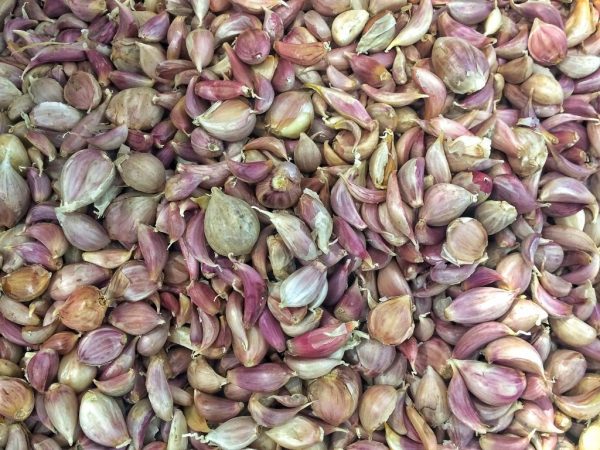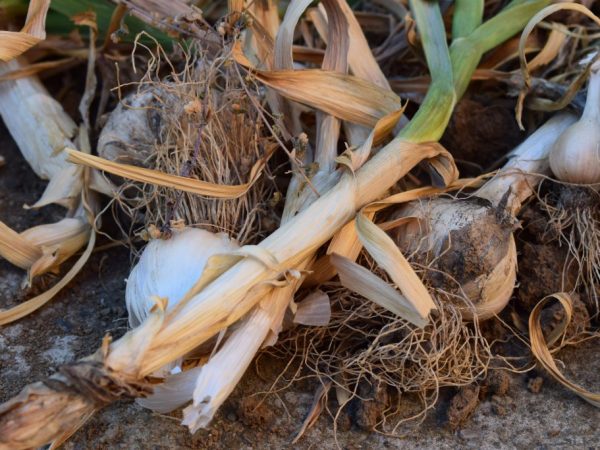Rules for growing garlic from bulbs
Many summer residents grow such a well-known seasoning as garlic in their garden. In this case, you can plant it with seeds and cloves. Growing garlic from bulbs, or seeds, is not known to everyone. This is one of the main ways to obtain a large garlic crop, grown for the purpose of propagation of the garlic variety.

Rules for growing garlic from bulbs
Features of the method
Airy bulbs with seeds are formed on garlic arrows during the period of its development and growth. Collected at the very top of the plant in inflorescences, they are covered with a film on top, and in appearance and size are similar to small teeth.
To come to seed cultivation of gardeners is often forced by the need to multiply the variety if the crop is damaged by fungal diseases and pests. All this reduces the yield indicators, and often leads to its complete death. Garlic bulbs, which are not damaged by pests, become the only source of restoration of the lost variety. The seeds are formed at the top of the arrow and are hidden in a reliable protective shell, so they always remain healthy, acting as high-quality planting material.
One mature head of garlic gives up to 10 healthy cloves, and 1 bulb is a hundred, and sometimes even more, ready-to-plant garlic seeds.
Dignity
Among the main advantages of seed growing:
- planting healthy planting material showing good germination results,
- the ability to propagate a lost variety,
- ease of planting in soil.
The convenience of planting a garlic crop with seeds is the ability to plant the bulbs in prepared soil, in contrast to planting with cloves, in which the seed, previously divided from a whole head and sorted by quality, will have to be planted according to GOST at the required depth each separately.
disadvantages
The seed growing method has its drawbacks.
- First of all, this is due to the fact that part of the seed material during frost can disappear without a trace and not rise. Some gardeners are not embarrassed by the potential loss of seed, since initially there is a large amount of it in the inflorescences, and the correct basic planting technologies make it possible to avoid this.
- Secondly, it is possible to get a decent harvest of garlic culture by seed cultivation only after 2 years, since in the first gardening season only one clove (bulb) will sprout from garlic seeds, which will have to be planted again the next year. But already in the second year from such a healthy bulb it is possible to grow a full-fledged garlic head.
Seed selection

We select only good seeds
Getting a good garlic harvest from seeds depends on how much attention has been paid to the quality of the planting material during its collection.For the formation of air bulbs, only strong garlic arrows are left, which begin to appear and grow in the second half of June. The rest of the arrows break off to give growth and development to the garlic heads. According to the number of garlic arrows, you should leave as much as it takes to collect to obtain the seed, on the basis that about 70-80 bulbs are formed on 1 arrow.
Seed collection
The grown bulbs are cut off closer to the second half of July, sometimes for spring garlic this period occurs in early August. In any case, an indicator that it is possible to cut off the tops with seeds is their burst protective capsule and the seeds that turned out to be outside.
In some cases, the protective film does not burst, but this does not mean at all that the seeds in it are not ripe. The color of the foliage, which turns yellow, helps to understand that it is time to cut the seeds.
Storage
Collected bulbs for subsequent cultivation of a garlic culture from them are dried in a shady place and then stored for storage until spring, until the moment of planting. You can store the seed at home for 2 years at room temperature. It will be correct if they are wrapped in paper packaging for storage or put in a cardboard box until spring.
Pre-planting preparation
Garlic seeds are sorted and then placed in an aqueous infusion made with wood ash. For marriage, those bulbs are selected that remain on the surface of the water.
Before planting, experienced gardeners store the planting material in the heat 30-40 days before planting, placed in the refrigerator, after removing the film from them. This will shorten the development time of the garlic and prevent the vitrification of the seeds. Growing garlic from uncooled bulbs often results in unripe head and small cloves. The planted chilled seeds grow until the beginning of August and are formed into 1 garlic head - one-tooth.
Autumn and spring planting with bulbs
Planting for the winter and sowing in the spring are similar in their technology to the methods that are used when sowing ordinary garlic cloves.
Sowing for the winter
Planting garlic seeds for the winter is considered the most popular among gardeners, begins until mid-October and can last until the first half of November. It all depends on the climatic conditions.
You can determine when you can plant garlic in bulbs by the temperature regime. The thermometer indicator should not fall below 5 '.
For seed sowing of garlic according to a multi-line tape scheme, small grooves are made in the beds to a depth of no more than 5 cm at a distance of up to 45 cm between the rows. After sowing the planting material, the seeds are covered with a layer of earth. Some gardeners prefer to mulch the garden.
For cold regions, planting the cultivation of garlic in bulbs with planting in the fall is not recommended.
Care for the winter planting follows the usual method, when the crop is harvested when the tips of the leaves turn yellow. The dried cloves are planted again in the fall at the time for planting winter crops.
Sowing in spring
Seed planting of garlic in spring is practically the same as planting winter garlic, with the exception of some peculiarities:
- unlike winter, spring garlic is planted at the very beginning of March, and at the same time, many summer residents are faced with a still solid earth that has not been warmed up by the sun,
- when seedlings appear for a garlic culture, proper care is required with feeding, watering and fighting pests and fungal diseases.
The beds for sowing spring garlic are usually prepared in the fall. They are mulched and covered with foil. Harvesting occurs as soon as the stems begin to slope to the ground. The harvested and dried garlic is planted at the same time as the winter one.
Non-transplant cultivation
With the direct method to grow garlic from bulbs in the open field, the cultivation of the crop takes place in the absence of transplants of the grown one-tooth, which allows you to grow an annual crop. This method allows you to reduce the time for collection and re-planting of seeds. The non-stop growing process includes several main stages.
- Initially, when bulbs form on the arrows in June, they track the moment to cut them until they have time to open. It is easier to track this by the appearance of yellowness on the foliage.
- The cut seed pods are dried for one to two days.
- Dried bulbs are planted according to the same rules as in spring and autumn for winter. The garden bed is mulched.
- Closer to mid-October, the ripe one-tooth is not dug out, but left in the ground. The garden bed is insulated for the winter.
Subject to all the rules of planting and care for the next year, by mid-June, you can harvest a finished crop of several kg with large heads of garlic and a large number of cloves.


